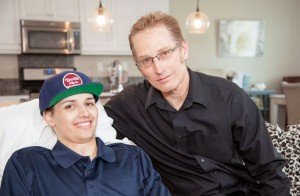 Parents Rodney and Annette Boesen were warned there was a good chance their son would be permanently paralyzed from the neck down. However, they also learned that Kris could possibly qualify for a clinical study that might help.
Parents Rodney and Annette Boesen were warned there was a good chance their son would be permanently paralyzed from the neck down. However, they also learned that Kris could possibly qualify for a clinical study that might help.
Leading the surgical team and working in collaboration with Rancho Los Amigos National Rehabilitation Center and Keck Medicine of USC, Charles Liu, MD, PhD, director of the USC Neurorestoration Center, injected an experimental dose of 10 million
«Typically, spinal cord injury patients undergo surgery that stabilizes the spine but generally does very little to restore motor or sensory function," explains Liu. «With this study, we are testing a procedure that may improve neurological function, which could mean the difference between being permanently paralyzed and being able to use one’s arms and hands. Restoring that level of function could significantly improve the daily lives of patients with severe spinal injuries.»
Two weeks after surgery, Kris began to show signs of improvement. Three months later, he’s able to feed himself, use his cell phone, write his name, operate a motorized wheelchair and hug his friends and family. Improved sensation and movement in both arms and hands also makes it easier for Kris to care for himself, and to envision a life lived more independently.
«As of 90 days
Doctors are careful not to predict Kris’ future progress.
«All I’ve wanted from the beginning was a fighting chance," said Kris, who has a passion for fixing up and driving sports cars and was studying to become a life insurance broker at the time of the accident. «But if there’s a chance for me to walk again, then heck yeah! I want to do anything possible to do that.»
Qualifying for the Study
Because the window for performing the surgery was tight, everything needed to go according to schedule in order for Kris to qualify.
Once Kris made the decision to pursue enrollment in the study, dozens of doctors, nurses, rehabilitation specialists and others sprang into action. Because he would need to provide voice confirmation of his desire to participate in the study, Kris had to be able to breathe without a ventilator. Weaning a patient from assisted breathing generally is a
In early April, a surgical team from Keck Hospital of USC carefully injected 10 million
Rodney and Annette Boesen say they are amazed at the level of collaboration and cooperation that enabled their son to participate in the study. «So many things had to happen, and there were so many things that could have put up a roadblock," marvels Rodney. «The people at Keck Medical Center of USC and elsewhere moved heaven and earth to get things done. There was never a moment through all of this when we didn’t think our son was getting world class care.»
About the Study
The pioneering surgery is the latest example of how the emerging fields of neurorestoration and regenerative medicine may have the potential to improve the lives of thousands of patients who have suffered a severe spinal cord injury.
The stem cell procedure Kris received is part of a Phase 1/2a clinical trial that is evaluating the safety and efficacy of escalating doses of
«At the 10 million cell level, we’re now in a dose range that is the human equivalent of where we were when we saw efficacy in


